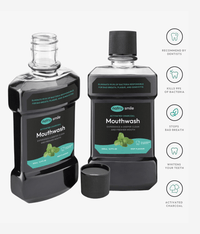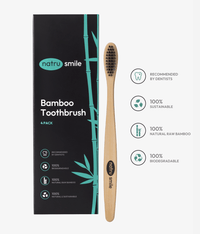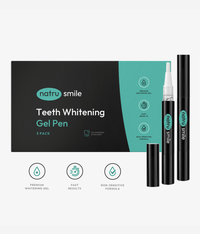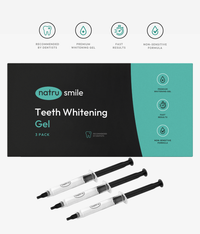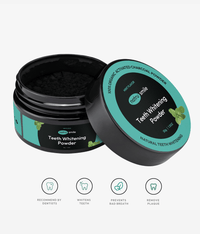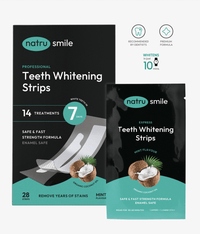
All products are certified by dental expert Dr. Greg Grillo
When it comes to dental treatments, one of the most common procedures is a dental crown. According to the American College of Prosthodontists, approximately 2.3 million implant-supported crowns are made every year.
Dental crowns are used to restore the shape and function of a damaged tooth or to cover up an implant. But when it comes time for your dentist to decide on which material should be used, you’ll have two options: metal or porcelain.
Both materials have their own advantages and disadvantages that should be taken into consideration before selecting one over the other. In this article, we’ll take a look at the differences between metal and porcelain dental crowns and which one may be best for you!
What Is The Difference Between Metal Crowns Vs. Porcelain? (A Summary)
The first difference between metal and porcelain crowns is the material that they are made from. Metal crowns are usually made of gold, palladium, or platinum alloys; while porcelain crowns are generally crafted from a ceramic material.
Metal crowns tend to be stronger than their porcelain counterparts and can withstand more force without breaking or cracking. This makes them ideal for teeth located in areas of high pressure, such as the back molars.
However, metal crowns may not be the best option if aesthetics are a concern. Since they’re made from a metallic material, they will have an unnatural sheen that can easily stand out in your smile.
In contrast, porcelain crowns are much more natural-looking and resemble the color of your existing teeth for a seamless aesthetic result.
Metal Crowns And Porcelain: Comparison
Now that you have a better idea of the differences between metal and porcelain crowns, how do you decide which one is best for you? We're about to break down the price, strength, appearance, safety, comfortability, and more of each option.
Safety
Both metal and porcelain crowns are safe, but porcelain crowns may have an advantage when it comes to safety. Metal is a more durable material than porcelain, meaning that the edges of a metal crown can be sharp. This could potentially lead to cuts or discomfort in the mouth if not properly fitted by your dentist.
Porcelain crowns, on the other hand, are crafted to fit perfectly against your existing teeth for a smooth transition with no sharp edges.
Duration
The amount of time it takes a dentist to install either type of crown is similar. Both require two visits: one to take impressions and another to fit and adjust the crown. Your first appointment will last around 50 to 90 minutes and will involve shaping the tooth for the crown, taking an impression, choosing the proper crown color, and placing a temporary crown.
The second appointment will be a lot shorter - around 20 to 30 minutes - where the dentist will fit the crown onto your teeth. In between those appointments, a dental lab will create the crown for your teeth.
Longevity
Metal crowns are the most durable option and will typically last up to 20+ years. Porcelain, on the other hand, is more prone to chipping or cracking and may only last for 5 to 15 years before needing replacement.
Comfortability
Porcelain crowns are generally more comfortable than metal crowns, as they fit more closely against your teeth and can be customized to better match the shape of your mouth.
Price
Overall, dental crown cost doesn’t differ too much between materials. Certain metal crowns can be more expensive than porcelain, but the price difference can vary depending on the type of metal used and where you live. On average, a typical metal crown will range from $800 to $2,500; while a porcelain one may cost anywhere from $1,000 to $3,000.
Material
Metal crowns are typically made from gold, palladium, or platinum alloys. Porcelain crowns, on the other hand, are crafted from a ceramic material and offer a more natural-looking result than metal.
Results
When it comes to long-term results, metal crowns tend to be more durable than porcelain and last longer (20+ years compared to 5 to 15 years). This is due to the strength of the metal material and its ability to withstand heavy chewing forces. Porcelain crowns are also strong but may not last as long as a metal one if they’re not properly cared for or maintained.
Strength
Metal crowns are generally stronger and more durable than porcelain crowns. The metal is able to withstand more force, making it the ideal choice for teeth located in areas of high pressure, like the back molars. Porcelain crowns are typically recommended for front teeth.
Tooth Appearance
Metal crowns have an unnatural sheen that can easily stand out in your smile, whereas porcelain crowns have a much more natural look and feel that mimics the color of your existing teeth for a seamless aesthetic result.
Tooth Function
Both metal and porcelain crowns work to restore the function of your teeth, but there is a slight difference in how this is achieved. Metal crowns are stronger than porcelain and provide more stability for molars that bear heavy pressure during chewing. Porcelain crowns, on the other hand, are better suited for restoring functionality to front teeth due to their natural-looking appearance.
How To Know If You Need A Metal Crown Or Porcelain Crown
It is ultimately up to your dentist to decide which type of crown is best for you, depending on the condition of your teeth and any other factors that may influence their decision.
In general, metal crowns are recommended for more extensive dental repairs or when a stronger material is needed. Porcelain crowns, on the other hand, are better suited for less invasive procedures or when aesthetics are a key factor in the procedure.
Here are some other factors you might want to consider:
- Budget - Metal crowns tend to be more expensive than porcelain, so if you’re on a budget, then you may want to opt for the latter.
- Longevity - Metal crowns last much longer than porcelain and are a better option for long-term dental protection.
- Comfortability - Porcelain is softer and more comfortable against your gums since it can be customized to fit your mouth better than metal.
Are Porcelain Crowns More Expensive Than Metal Crowns?
The answer depends on what kind of metal crown you are considering. A gold tooth crown or platinum crown tends to be more expensive than porcelain crowns, while palladium and stainless steel crowns may cost the same or even less than a porcelain one. Ultimately, the price will depend on the type of metal used and where you live.
Want to learn more about porcelain crowns? We address some frequently asked questions down below.
How Long Does A Porcelain Crown Last?
Porcelain crowns typically last between 5 and 15 years, depending on the quality of care they receive. With proper oral hygiene and regular dental visits, porcelain crowns can last even longer than that.
Is A Porcelain Crown Good?
Porcelain crowns are a great choice for restoring damaged teeth and improving their appearance. They’re an ideal choice for many people because they’re strong, durable, and look and feel like natural teeth.
Do Porcelain Crowns Turn Yellow?
Porcelain crowns are designed to be stain-resistant, so they shouldn’t discolor over time. While teeth are porous and susceptible to staining, porcelain crowns are glazed and sealed, making them more resistant to discoloration. However, improper dental hygiene and certain lifestyle habits, such as smoking, can cause porcelain crowns to become slightly stained or discolored.
Do Porcelain Crowns Crack Easily?
Porcelain crowns are incredibly durable, but if they’re subjected to excessive force or trauma, it’s possible for them to break or chip. When comparing porcelain crowns to metal alternatives, they’re a lot less resistant to wear and tear. If your porcelain crown cracks, a new crown may need to be placed.
What Are The Disadvantages Of Porcelain Crowns?
The main disadvantage of porcelain crowns is that they can be quite expensive. They also require extra time and skill to create, which means the procedure may take longer than other dental treatments.
Porcelain crowns don’t last as long as metal crowns, but going to regular check-ups with your dentist will help ensure your crown is still functioning properly.
Can Porcelain Crowns Fall Out?
Porcelain crowns are designed to last for several years, but they can still fall out due to trauma or decay. Practicing good oral hygiene and attending regular check-ups with your dentist can help ensure that your porcelain crown stays in place.
Do Porcelain Crowns Look Natural?
Porcelain crowns look very natural and are designed to blend in with your other teeth. The material itself is highly customizable, which allows the dentist to create a crown that looks just like one of your original teeth.
Are Porcelain Crowns Painful?
The procedure of placing a porcelain crown is not typically painful, as the area will be numbed with an anesthetic prior to the start of the procedure. After the procedure, you may experience some minor tooth crown pain, discomfort, and sensitivity for a few days, but this should subside as your mouth adjusts to your new crown.
Do Porcelain Crowns Get Cavities?
Porcelain crowns, like any other dental appliance, can get cavities if not properly taken care of. For example, plaque can form around the gum line between the tooth and crown.
Cavities can also form underneath the crown, even though crowns are good at protecting teeth from decay. Bacteria can collect underneath the crown, and a cavity can then form. In this case, the cap will need to be removed and replaced after the cavity is taken care of.
Just as it’s crucial to brush and floss regularly without crowns, it’s also important to do so with a porcelain crown in place.
Can I Chew Gum With Porcelain Crowns?
Yes, you can chew gum with porcelain crowns. But you might want to choose sugar-free gum because sugary gum can increase the risk of cavities and decay. As well, remember that your dental work may not feel as natural as your own teeth when biting into harder food items such as nuts or hard candy, especially at the start.
Even when you’ve gotten your permanent crown fitted, there are still certain foods you might want to avoid or take more care when eating. For instance, sticky foods that can pull and dislodge your crown and hard foods that can chip your crown.
Are Porcelain Crowns Better Than Gold?
When it comes to crowns, the type you should get depends on your personal preference and what is best for your particular situation. Porcelain crowns are more aesthetically pleasing than gold or metal ones, as they look more natural and can be custom-designed to match your other teeth.
On the other hand, metal and gold crowns tend to be stronger and sturdier than porcelain ones, so they may be a better choice if strength is an issue.
How Do I Keep My Porcelain Crown White?
The best way to keep your porcelain crown white is by practicing good oral hygiene, such as brushing twice a day and flossing daily. This will help remove plaque and food particles that can cause staining. Additionally, avoiding stain-causing foods and beverages like coffee, tea, red wine, and berries can help keep your crown looking its best.
Is Porcelain Stronger Than Teeth?
Dental-grade porcelain is generally considered to be as strong or stronger than tooth enamel, but not always. Porcelain can also be brittle and prone to fracturing in those that grind their teeth or clench their jaws.
When it comes to needing crowns, though, porcelain is a great choice, as the dentin and pulp layers of your tooth act as a fantastic foundation for the material. Porcelain crowns professionally fitted by a dentist to fit with your healthy tooth structures will ensure that the porcelain is as strong as your natural teeth.


